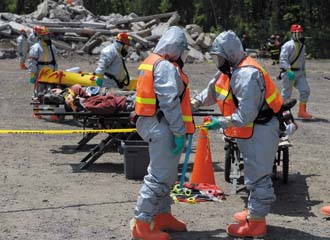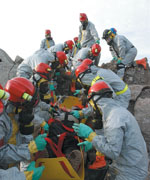Fight Against Deadly Agents Expands
 |
Members of the New York Army National Guard Chemical, Biological, Radiological, Nuclear and High-yield Explosives (CBRNE) Enhanced Response Force Package (CERFP) prepare to decontaminate victims of a simulated dirty bomb incident during training at the New York State Office of Fire Prevention and Control Training Site in Colonie, New York. The National Guard now is in the process of standing up Homeland Response Forces (HRFs) to further enhance disaster response in the event of a CBRNE event. |
The
The remaining eight HRFs are scheduled to stand up by fiscal year 2012 in
HRFs will be considerably larger than their CERFP predecessors. A typical CERFP has an approximate total of 170 members: 45 on a medical team; 50 on a search and extraction team; and the remaining 75 on a decontamination team. HRFs will have approximately 570 total members. They will have the same numbers and teams as the CERFPs, but each will include an additional 200-person security team and a 200-member command and control staff. Similar to CERFPs, the response forces will be at their posturing location and ready to deploy within six to 12 hours.
“[HRFs are] not really adding a capability,” says Lt. Col. Keith D. Bauder, ANG, chief, Combating WMD Division at the National Guard Bureau. “They’re increasing the amount of lifesaving capability that will be available on scene quickly.” Col. Bauder also is the civil support team program manager for the National Guard Bureau. The command and control element will benefit response situations in which multiple Guard units likely will respond. Having a structure in place above the current one will help the direction of forces and movements.
The U.S. Defense Department’s decision to implement HRFs is part of a larger reorganization of its CBRNE consequence management enterprise initiated during the 2010 Quadrennial Defense Review. The department plans the response forces to be a key element of the enterprise. Other units in the group include one defense CBRNE Response Force, formerly called the CBRNE Consequence Management Response Force; two consequence management command and control elements; 57 WMD Civil Support Teams; and the 17 CERFPs.
When the National Guard Bureau began the effort to stand up HRFs, it sent out a request asking interested states to submit proposals explaining why they were the best choice as a location and how they would carry out the responsibilities. Col. Bauder says some states joined forces and made joint pitches for how they would source an HRF. To determine where to establish the response forces, decision makers created a matrix to review the information provided. Questions included whether states had the force structure to field an HRF, the types of forces available and if states already had a CERFP. The chief of the National Guard Bureau made the final basing decisions.
To staff the response forces across the country, the host states will have in place Active Guard Reserve members whose full-time positions will be to run the day-to-day management of the HRFs. The remainder of personnel will be traditional Guardsmen with other jobs who will be called upon as needed. In normal National Guard operations, full-time equivalents are approximately 9 percent of the force. In an HRF state, that number will jump to 25 percent. States will not add personnel to staff the HRFs but will receive extra funding from the Defense Department to put the necessary people on orders. In the event of an incident, the location and severity would affect funding decisions. Governors might use state money, or the Defense Department could provide the authority to supply needed resources using different types of federal funding.
 |
New York Army National Guard CERFP members rescue a mock casualty from a rubble heap that simulates a hospital destroyed in a magnitude 5.9 earthquake during operation Vigilant Guard in 2009. By establishing HRFs in 10 states including New York, the National Guard will build on CERFP capabilities to improve response efforts after a catastrophe. |
Governors seeking aid primarily will work through the Emergency Management Assistance Compact (EMAC), a national mutual-aid partnership agreement that allows state-to-state assistance during governor- or federally declared emergencies. In addition, memorandums of understanding governing the employment of HRFs within and outside host states and FEMA regions will be established.
Col. Bauder believes it is unlikely that a state would request HRF assistance and be denied the aid. “It would be surprising if someone asked for help and was told ‘no,’” he says. “The whole idea of the Guard is we support our own states and we support our neighbors.”
An official with the Washington National Guard concurs with Col. Bauder. Through EMAC, the governor of
“When we think of HRF, we think of capability and capacity,” the official says. Enhancing both of those is a benefit to the state and region. If a major CBRNE incident occurs, “it’s great to know we have the HRF in our backyard that can respond,” the official adds.
The Washington National Guard sees itself as a pioneer in many ways, leading the way for establishing HRFs. Guidance does come down from the National Guard Bureau, but the first two states have plenty of opportunities to act as trailblazers. Their choices will serve as a model for other states and regions to follow.
Drawing personnel from units comes with some drawbacks, especially in training situations. HRF members will train on both their CBRNE and wartime missions, meaning that Guard leadership has to ensure training efficiency is maintained for each set of skills. Some tasks are common to both missions, but the differences demand a significant commitment from troops to sustain proficiency. States will receive funding from the Defense Department for an additional 39 days of training beyond the standard one weekend a month and two weeks a year duty commitment for HRF personnel. This extra preparation will incorporate payment to attend specific schools and training as a unit and as an entire group.
Just as with other requirements, the commander’s mission-essential task list will drive HRF training. The list for the HRF helps identify the specialized individual, leader and collective tasks necessary to accomplish the CBRNE mission. In addition to learning new technical skills, soldiers and airmen must learn how they fit into the overall Incident Command System, which is the standardized, on-scene, all-hazards incident management approach that provides a framework for coordinating response forces at an incident site.
Despite challenges, the Ohio National Guard is excited to add an HRF to its CBRNE capabilities. “The addition of this HRF is nationally significant and greatly improves our ability to defend the homeland,” says Maj. Gen. Gregory L. Wayt, ARNG, Ohio National Guard adjutant general.
One of the issues HRF members will have to resolve during training is communication. Though Col. Bauder says he does not know yet exactly what the overall headquarters element will use, troops likely will employ new technologies to communicate and interact among different units. Many of them, such as Air National Guard medics and Army elements, will not have worked together in the past. Col. Bauder explains that some technology transfer will be necessary to work the interoperability piece of HRF efforts, and that he expects units to resolve issues during training. The National Guard Bureau will take steps such as providing handheld radios to help bridge communications gaps, he adds.
In terms of response technology, the response force personnel should use many of the same capabilities CERFPs already are employing, so that former and new units remain interoperable with the first-responder community. The colonel explains that the Guard plans to take advantage of new technology, such as equipment that would help search and rescue personnel see better into a collapsed building, as it becomes available.
HRF personnel will have to interoperate with nonmilitary partners as well as troops from other units. “The interagency partners will always play a large role both on the state and federal side,” Col. Bauder explains. “The Guard is always supporting someone else.” Guard members already work daily with other agencies that will respond to the scene of a disaster. This helps them better understand other organizations’ procedures while simultaneously giving them an opportunity to showcase their own.
Academia plays a role as well, though a slightly more ambiguous one. Academic institutions generally do not send out response personnel, but they do assist with training. They also offer technologies that aid in accomplishing tasks such as information management and develop new technologies that can transfer into the field.
WEB RESOURCES
Emergency Management Assistance Compact: www.emacweb.org
141st Air Refueling Wing: www.141arw.ang.af.mil
96th Troop Command: http://96tc.washingtonarmyguard.org
Ohio National Guard: www.ong.ohio.gov




Comments